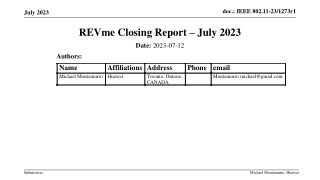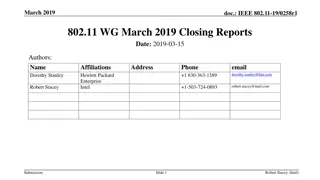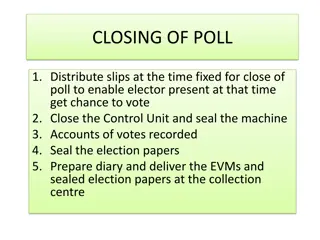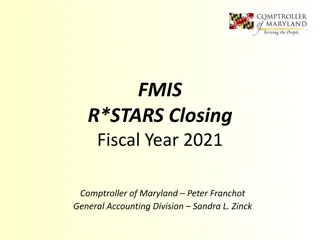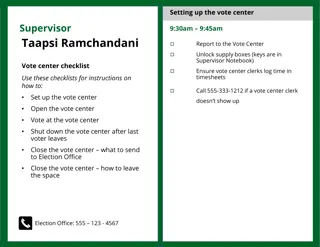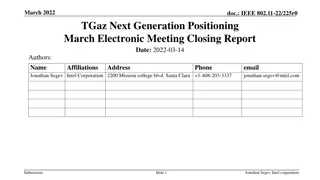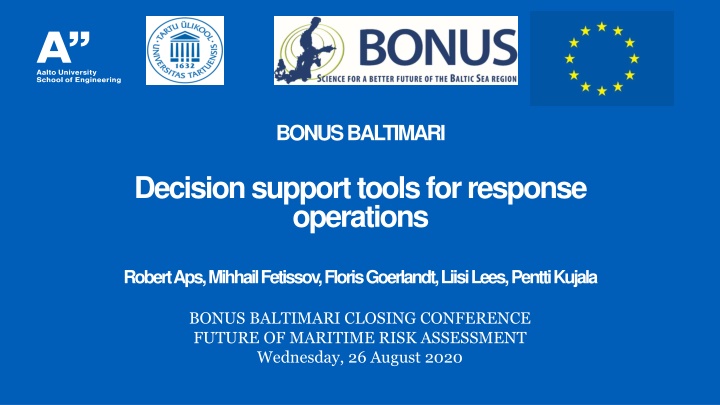
Spatial Decision Support Systems in Emergency Response Operations
This article delves into the significance of Spatial Decision Support Systems (SDSS) in emergency response operations, particularly focusing on oil spill emergencies. It highlights the challenges and complexities involved in decision-making processes, emphasizing the incorporation of spatial and non-spatial data to facilitate informed decision-making. The text also discusses the scientific basis of SDSS, knowledge gaps in handling big data, and the critical role of SDSS in addressing urgent, life-or-death situations.
Download Presentation

Please find below an Image/Link to download the presentation.
The content on the website is provided AS IS for your information and personal use only. It may not be sold, licensed, or shared on other websites without obtaining consent from the author. If you encounter any issues during the download, it is possible that the publisher has removed the file from their server.
You are allowed to download the files provided on this website for personal or commercial use, subject to the condition that they are used lawfully. All files are the property of their respective owners.
The content on the website is provided AS IS for your information and personal use only. It may not be sold, licensed, or shared on other websites without obtaining consent from the author.
E N D
Presentation Transcript
https://upload.wikimedia.org/wikipedia/lv/c/ce/T%C3%9C_logo.pnghttps://upload.wikimedia.org/wikipedia/lv/c/ce/T%C3%9C_logo.png BONUS BALTIMARI Decision support tools for response operations Robert Aps, Mihhail Fetissov, Floris Goerlandt, Liisi Lees, Pentti Kujala BONUS BALTIMARI CLOSING CONFERENCE FUTURE OF MARITIME RISK ASSESSMENT Wednesday, 26 August 2020
Scope and content Referring to Jankowski (2008) and Keenan & Jankowski (2019), spatial data are data connected to a location, a place on the earth. Based on that the spatial decision-making exploits the geographic relationships within this data to make decisions. Spatial Decision Support Systems (SDSS) combine spatial and non-spatial data, the analysis and visualization functions of Geographic Information Systems (GIS), and decision models in specific domains, to compute the characteristics of problem solutions, facilitate the evaluation of solution alternatives, and the assessment of their trade-offs.
Scientific basis Keenan & Jankowski (2019) stress that emergency problems represent a leading edge of DSS application, owing to the life or death nature of the issues that arise, the urgency of the problems, the complexity of the modelling required and consequentially the data required for this modelling, and the challenge of making these powerful techniques available in a way that is easily controlled by the decision maker, often in demanding circumstances.
Knowledge gaps One of the knowledge gap issues arising with big data is that data from different sources are aggregated, including spatial data, and analysed without a good understanding of the data sources, which is at odds with the DSS concept of an informed decision-maker directing the process (Kitchin, 2014). This means that finding better ways to handle uncertainties within SDSS may be important, or to investigate alternatively ways to communicate these data-related uncertainties to end-users.
Oil spill emergency response Oil spill response is an extremely complex and challenging cross-disciplinary activity. In the decision-making process, it combines a wide range of issues and activities under emergency conditions, including the nature of the material spilled, changes in physical and chemical properties (weathering) and biodegradation, local environmental conditions, sensitivity of impacted natural resources, possible socio-cultural, economic, and economic effects, and effectiveness of response/clean-up technologies (Ivshina et al., 2015).
Oil spill response and impacts Oil spills can have severe long-term impacts on near-shore biodiversity and functioning. Advice on sensitive shoreline likely to be impacted by the oil washing ashore is of critical importance in order to support decisions whether or not a response is necessary or what kind and extent of response is appropriate. Choices made in clean-up strategies and the decision- making process in the aftermath of a spill are significantly affecting the clean-up costs.
Framework for classifying oil spill response and impacts (adapted from Chang et al, 2014)
Critically important information is needed Environmental Sensitivity Index (ESI) maps have been an integral component of oil-spill contingency planning and response in the United States since 1979, serving as a quick reference for oil spill responder (NOAA, 2002). The ESI ranks shoreline into 10 classes in relation to sensitivity, natural persistence of oil, and ease of clean-up. Some countries outside the US have adopted the ESI approach to classify their own shorelines for similar oil spill contingency planning, the resulting maps being referred to as Regional Environmental Sensitivity Index (RESI) maps.
Critical knowledge gaps need to be eliminated Oil spill accident history and simulations show that once the oil spill has occurred at sea, it is almost impossible to prevent it from reaching ashore. It is therefore critical to know which ecological and human-use resources are likely to be impacted by the oil in order to support decisions whether or not a response is necessary or what kind and extent of response is appropriate.
More efficient approach has to be implemented Net Environmental Benefit Analysis (NEBA) is a structured approach used by the response community and preparedness planning and response, to compare the environmental benefits of potential response tools and develop a response strategy that will reduce the impact of an oil spill on the environment. stakeholders during oil spill Integration challenge to overcome. The developed Next Generation SmartResponseWeb (NG-SRW) SDSS methodology (HELCOM, 2018) for spilled oil potential impact assessment related to sensitive shoreline, ecological and human-use resources enables the response authorities to better understand the inherent uncertainty in forecasting the outcomes of oil spill, and the likely variability in actual results seen.
Next generation SmartResponse Web (NG SRW) Application is based on operational concepts and technical implementations for user defined Common Situational Awareness (CSA) with aim to create, visualize, and share decision focused views of the oil accident operational environment for decision makers 1) to support accurate CSA and timely decision-making in a distributed Net- centric operational environment and 2) to make available a considerable amount of information that can be injected into an operational picture. NG-SRW application enables the integration of spill monitoring and evaluation functions directly into oil spill preparedness and response management processes (HELCOM, 2018).
Real-time response SDSS Advance planning SDSS can use computationally intensive models as execution time is less urgent, while real-time response SDSS (Zerger & Ingle-Smith, 2003) may need updated spatial data and requires the ability to process that data quickly Emergency response support requires spatial data sharing between organizations and also represents a challenging GDSS application (Breen Joseph & Parrish David, 2013) Emergency systems require rapid decision making, and the clarity of information display plays a huge role in their success. In order to effectively support complex spatial decision-making, SDSS must provide rich problem representations, including the use of dashboards with multiple GIS layers linked with graphs, tables, and text and/or 3D visualization (Andrienko et al., 2007) to inform multiple decision-makers
Acknowledgements BONUS BALTIMARI has received funding from BONUS (Art. 185), funded jointly by the EU and the Swedish Research Council Formas, the Polish National Centre for Research and Development, and the Estonian Research Council.

